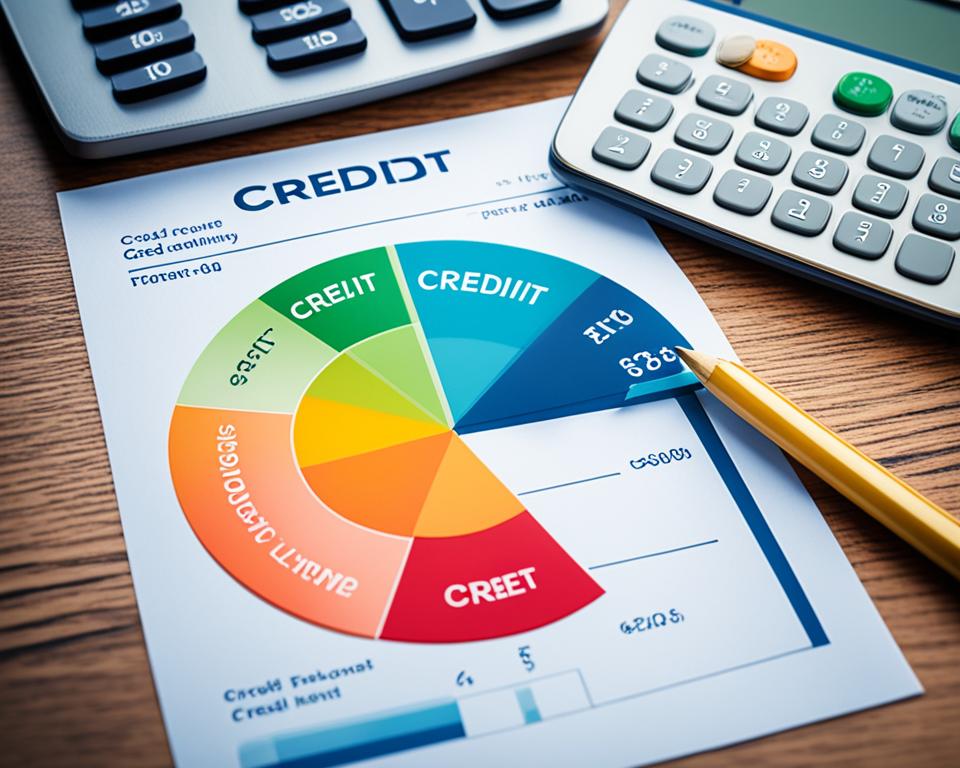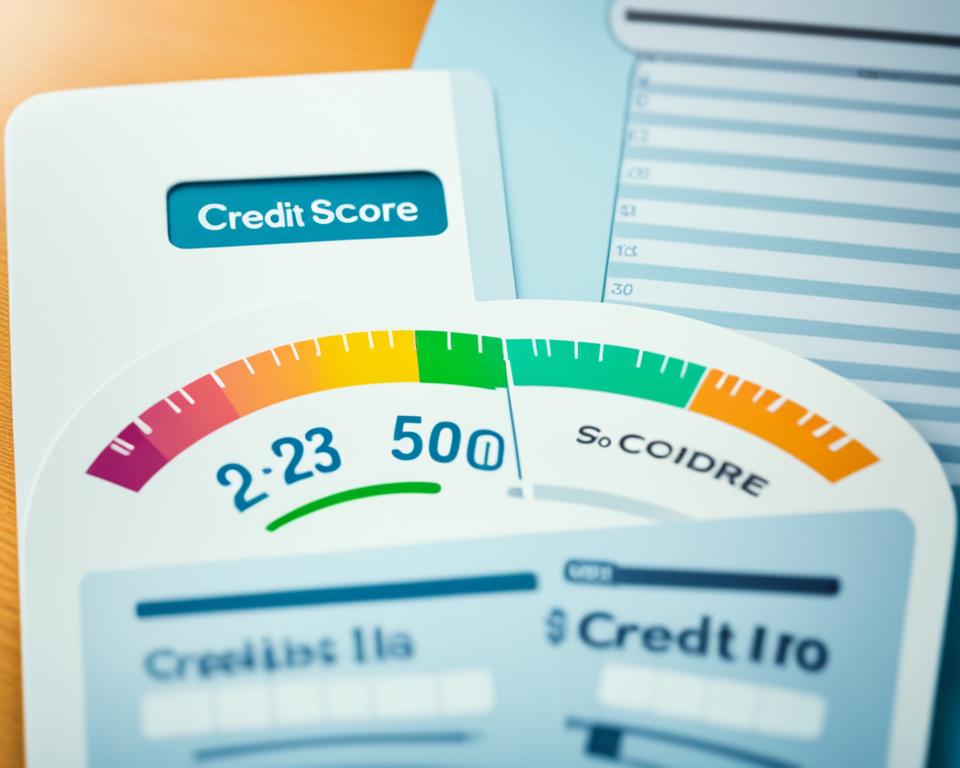When it comes to managing your finances, determining the ideal credit limit is a crucial step. Having the right credit limit can help you maintain a healthy credit score, access better credit opportunities, and achieve your financial goals. But how much credit limit should you have?
Several factors come into play when determining the ideal credit limit that aligns with your financial needs and goals. It’s important to understand these factors to make informed decisions and ensure a healthier financial future.
From your credit history and credit score to your income level and financial stability, various elements can affect your credit limit. By assessing your unique circumstances, you can find the balance that allows you to use credit responsibly while maintaining a good credit utilization ratio.
Key Takeaways:
- Determining the ideal credit limit requires assessing your financial goals and circumstances.
- Factors like credit history, credit score, income level, and financial stability impact your credit limit.
- Experts generally recommend keeping your credit utilization ratio below 30%.
- Regularly monitoring your credit limit helps you stay on top of any changes or updates.
- Maintaining a healthy credit limit offers flexibility and improves creditworthiness.
Factors Affecting Credit Limit
When it comes to determining the credit limit on your credit card, several factors come into play. These factors are considered by the credit card issuer to assess your creditworthiness and decide the appropriate limit for your card. Understanding the factors affecting your credit limit can help you make informed decisions regarding your credit card usage and financial management.
Here are some key factors that can influence your credit limit:
- Credit History: Your credit history plays a significant role in determining your credit limit. It includes factors such as your credit accounts, payment history, and any negative marks like late payments or defaults.
- Credit Score: Your credit score is a numerical representation of your creditworthiness. It is based on various factors such as your payment history, credit utilization, length of credit history, and types of credit used. A higher credit score generally leads to a higher credit limit.
- Income Level: The income level is another crucial factor that lenders consider when determining your credit limit. A higher income level may result in a higher credit limit as it reflects your ability to repay debts.
- Financial Stability: Lenders also assess your overall financial stability, which includes factors such as your employment history, savings, and investments. They look for signs of stable income and responsible financial management.
To gain a better understanding of the appropriate credit limit for your financial situation, you can use a credit limit calculator. This helpful tool takes into account your income, expenses, and credit profile to provide an estimate of the credit limit that suits your needs. It can assist you in making informed decisions to avoid overextending your credit and maintain a healthy financial balance.
Ideal Credit Limit Range
Determining the ideal credit limit can be a challenging task as it varies based on individual circumstances. However, there are guidelines recommended by experts to help you optimize your credit limit and maintain a good credit score.
One important aspect to consider is your credit utilization ratio, which is the percentage of your available credit that you are currently using. To optimize your credit limit and keep it within an ideal range, financial experts generally suggest keeping your credit utilization ratio below 30%.
This means using no more than 30% of your available credit limit. By keeping your credit utilization ratio low, you demonstrate responsible credit usage and maintain a healthy financial standing. Lenders and credit reporting agencies view a lower credit utilization ratio positively, which can have a positive impact on your credit score.
Optimizing Your Credit Limit for Success
Optimizing your credit limit within the recommended range involves thoughtful credit management and financial planning. Consider the following strategies:
- Regularly review your credit statements to stay aware of your balances and credit utilization. This will help you identify areas where you can adjust your spending habits or payment schedules to optimize your credit limit.
- Make timely payments to avoid additional fees and interest charges. Paying off your balances in full and on time not only demonstrates good financial management but also keeps your credit utilization ratio low.
- Request a credit limit increase if you believe your current limit is restricting your financial goals. However, be cautious when requesting a higher limit, as it may tempt you to overspend. Only increase your limit if you have a responsible spending plan in place.
Remember, maintaining a credit limit that aligns with your financial goals and staying within the recommended credit utilization ratio is key to a healthy credit score and optimized financial stability.
| Credit Utilization Ratio | Recommended Range | Impact on Credit Score |
|---|---|---|
| Below 10% | Excellent | Positive impact; demonstrates responsible credit usage |
| 10% – 30% | Ideal | Positive impact; indicates responsible credit management |
| Above 30% | High | May have a negative impact; signals higher credit risk |
As shown in the table above, maintaining a credit utilization ratio below 30% falls within the ideal range. This demonstrates responsible credit utilization and can have a positive impact on your credit score. Ensure you strive to optimize your credit limit within this recommended range to achieve financial success.
Maximizing Your Credit Limit
If you’re managing your credit responsibly and have a good credit history, you have the opportunity to maximize your credit limit and potentially enhance your financial standing. By strategically increasing your credit limit, you can improve your credit utilization ratio and potentially boost your credit score.
One way to maximize your credit limit is by requesting a higher credit limit on your existing credit card. This can be done by contacting your credit card issuer and providing them with information about your financial stability and responsible credit management. If approved, a higher credit limit will provide you with more available credit, enabling you to increase your credit utilization ratio and potentially improve your credit score.
Remember, when requesting a higher credit limit, it’s crucial to maintain responsible credit usage and avoid incurring unnecessary debt.
Another option to maximize your credit limit is by opening a new credit card. This can provide you with additional available credit, ultimately increasing your credit limit. However, it’s important to carefully consider the implications of opening a new credit card, as it can impact your credit score temporarily due to a hard inquiry and potentially lower the average age of your credit accounts.
Before opening a new credit card, make sure to thoroughly research and compare different card offers to find the one that best suits your needs and offers favorable terms.
By increasing your credit limit, you’ll have more financial flexibility and a higher credit utilization ratio that aligns with optimal credit scoring guidelines.

Image: Maximizing your credit limit can help improve your credit utilization ratio and boost your credit score.
| Benefits of Maximizing Your Credit Limit: |
|---|
| 1. Improved credit utilization ratio |
| 2. Potential boost in credit score |
| 3. Increased financial flexibility |
| 4. Access to better credit opportunities |
Monitoring Your Credit Limit
Regularly monitoring your credit limit is essential for maintaining control over your financial health. It allows you to stay informed about any changes or updates that may impact your credit limit and take appropriate action as needed. By keeping a close eye on your credit limit, you can ensure that it aligns with your financial goals and make adjustments if necessary.
One of the key benefits of credit limit monitoring is the ability to detect any fraudulent activity or errors in your credit report that could potentially impact your credit limit. Financial fraud is unfortunately a prevalent issue, and monitoring your credit limit can help you identify any unauthorized transactions or suspicious activity promptly. By catching these issues early on, you can take the necessary steps to protect your financial well-being.
Additionally, credit limit monitoring provides you with valuable insights into your credit utilization. This is the ratio of your current credit card balances to your total available credit. By regularly evaluating this ratio, you can ensure that you’re effectively managing your credit and keeping your utilization within a healthy range. Maintaining a low credit utilization ratio is crucial for maintaining a good credit score and demonstrating responsible financial behavior.
Whether it’s through your credit card provider’s online portal or by using credit monitoring services, keeping tabs on your credit limit can be a straightforward and effortless process. Automating alerts or notifications can also help you stay updated on any changes to your credit limit.
By proactively monitoring your credit limit, you can stay in control of your financial well-being and make informed decisions to optimize your credit profile.
Benefits of Credit Limit Monitoring:
- Stay aware of changes or updates to your credit limit
- Detect and prevent fraudulent activity or errors in your credit report
- Maintain a healthy credit utilization ratio
- Protect your financial well-being
Regular credit limit monitoring empowers you to make informed decisions about your financial future. Consider it an essential part of maintaining a healthy credit profile and staying vigilant against potential credit-related risks.
| Benefits of Credit Limit Monitoring |
|---|
| Stay aware of changes or updates to your credit limit |
| Detect and prevent fraudulent activity or errors in your credit report |
| Maintain a healthy credit utilization ratio |
| Protect your financial well-being |
Assessing Your Credit Limit
To ensure that your credit limit aligns with your financial needs and goals, it’s important to assess it periodically. By evaluating your credit limit and making necessary adjustments, you can optimize your credit utilization ratio and maintain overall financial well-being.
- Your Current Financial Situation: Review your income, expenses, and financial obligations to determine if your credit limit adequately supports your needs. Consider any changes in your financial circumstances since you obtained the credit.
- Utilization Ratio: Analyze your credit utilization ratio, which is the percentage of your available credit that you’re currently using. Ideally, you should aim to keep your utilization below 30% to maintain a healthy credit score.
- Future Financial Goals: Evaluate your long-term financial goals and determine if your current credit limit allows you to work towards achieving them. Consider factors such as home purchases, education expenses, or business ventures that may require additional credit access.
- Potential Credit Needs: Anticipate any upcoming credit needs, such as major purchases or investments, and assess whether your current credit limit can accommodate them. This will help you avoid being caught off guard or relying on high-interest loans.
By conducting a thorough credit limit assessment, you can make informed decisions about your credit usage and determine if adjustments are necessary. Remember, maintaining an appropriate credit limit is crucial for maintaining good credit health and financial stability.
Credit Limit Guidelines
While there are no strict guidelines for how much credit you should have, it’s generally recommended to accept as much credit as lenders are willing to offer you, as long as you can use it responsibly. Keeping your credit utilization below 30% and paying off your balances regularly are crucial factors to consider when determining your credit limit.
| Factors to Consider | Credit Limit Guidelines | |
|---|---|---|
| Acceptable | Not Recommended | |
| Credit Utilization Ratio | > 30% | |
| Balances | Regularly paid off | Accumulating interest |
| Financial Responsibility | Consistently responsible | Excessive spending |
| Credit Score Impact | Positive | Negative |
By accepting credit up to the maximum offered by lenders, you can increase your available credit and potentially improve your credit utilization ratio. However, it’s important to manage your credit responsibly to avoid overspending and accumulating debt. Keeping your credit utilization ratio below 30% and paying off your balances regularly can help maintain a healthy credit score and overall financial stability.

Understanding Credit Limits
A credit limit is an essential concept to grasp when it comes to managing your finances effectively. It refers to the maximum amount of money that you can borrow from a line of credit, such as a credit card. Your credit card issuer sets this limit based on several factors, including your creditworthiness and financial stability.
Understanding your credit limit is crucial for maintaining a good credit score and making informed financial decisions. It serves as a boundary for your borrowing capacity and helps prevent excessive debt accumulation. By staying within your credit limit, you demonstrate responsible credit usage, which can positively impact your creditworthiness.
How Credit Limits Are Determined
The credit card issuer evaluates multiple factors to determine your credit limit. These factors typically include:
- Your credit history and credit score
- Your income level and stability
- Your existing debt obligations
Based on the information provided, the credit card issuer decides upon a credit limit that they deem appropriate for your financial situation. It’s important to note that credit limits can vary from person to person, as they are tailored to individual circumstances.
Managing Your Credit Limit
Effectively managing your credit limit is essential for maintaining financial stability and a good credit score. Here are some key aspects to consider:
- Stay within your credit limit: Exceeding your credit limit can result in declined transactions and additional fees.
- Monitor your credit utilization: Credit utilization is the percentage of your available credit that you are currently using. Aim to keep it below 30% to maintain a healthy credit score.
- Pay your balances on time: Timely payments contribute to a positive credit history and demonstrate responsible credit management.
- Regularly assess your credit limit: Periodically review your credit limit to ensure it aligns with your financial goals and adjust as necessary.
By managing your credit limit effectively, you can cultivate a healthy financial profile and improve your overall creditworthiness.
“The credit limit is a crucial aspect of managing your credit effectively. It establishes boundaries for your borrowing capacity and plays a significant role in maintaining a good credit score.”
Effects of Exceeding Your Credit Limit
Exceeding your credit limit can have significant consequences on your financial well-being. While it may be tempting to make purchases beyond your credit limit, it’s important to understand the potential effects that could arise.
If you surpass your credit limit, your credit card issuer may decline any transactions unless you have opted into over-limit protection. This means that you may not be able to complete essential purchases or cover unexpected expenses when you need to.
Additionally, going over your credit limit can result in additional fees, such as over-limit fees. These fees can quickly accumulate and contribute to your overall debt burden. It’s crucial to note that these fees often come with high interest rates, making it more challenging to pay off your debt in a timely manner.
“Going over your credit limit can lead to a never-ending cycle of debt, as the fees and interest charges can make it difficult to catch up,” warns financial advisor Jennifer Thompson.
Moreover, exceeding your credit limit can negatively impact your credit score. Your credit utilization ratio, which measures the percentage of available credit you are using, plays a significant role in determining your creditworthiness. When you go over your credit limit, your credit utilization ratio increases, potentially signaling to lenders that you may be relying too heavily on credit and potentially experiencing financial strain.
To illustrate the potential impact, here is a comparison of two individuals, each with a credit limit of $5,000:
| Scenario | Individual A | Individual B |
|---|---|---|
| Credit Balance | $4,000 | $6,000 |
| Credit Utilization Ratio | 80% | 120% |
| Effect on Credit Score | Negative | Significantly Negative |
In this example, Individual A is using 80% of their credit limit, which is still considered high. However, Individual B has exceeded their credit limit by $1,000, resulting in a credit utilization ratio of 120%. This excessive credit utilization can have a severe negative impact on their credit score.
To avoid these consequences, it is crucial to stay within your credit limit. By spending responsibly and keeping your credit utilization ratio below the recommended 30%, you can maintain a healthy credit score and financial stability.
Remember, your credit card serves as a valuable tool to manage your finances and reach your financial goals. By understanding the effects of exceeding your credit limit, you can make informed decisions and maintain control over your financial well-being.
Impact of Interest Charges and Fees
When managing your credit limit, it’s essential to take into account the impact of interest charges and fees. These factors can significantly affect your overall credit limit utilization and have financial implications. By understanding how interest charges and fees are applied, you can effectively manage your credit limit and avoid unnecessary debt.
Interest charges can accumulate on unpaid balances, causing your debt to grow over time. These charges are usually based on an annual percentage rate (APR) and can vary depending on your credit card agreement. It’s crucial to pay off your balances in full each month to avoid accumulating interest charges and increase your credit utilization ratio.
In addition to interest charges, certain fees may also contribute to your credit limit. While credit card fees can vary, some common ones include annual fees, balance transfer fees, late payment fees, and cash advance fees. These fees are typically added to your credit card balance and can count towards your overall credit limit utilization.
To effectively manage your credit limit, it’s important to stay aware of these charges and fees. By paying attention to your credit card statements and understanding the terms and conditions of your credit card agreement, you can make informed decisions about your credit limit utilization. Regularly monitoring your credit card activity can help you stay on top of any interest charges or fees that may be impacting your credit limit.
“Understanding how interest charges and fees impact your credit limit is crucial for maintaining control of your finances. By staying informed and taking proactive steps to manage these factors, you can maintain a healthy credit limit and avoid unnecessary financial burdens.”

Comparing the Impact of Interest Charges and Fees on Credit Limit
| Interest Charges | Fees | Effect on Credit Limit |
|---|---|---|
| Accumulate on unpaid balances | Contributed by various types of fees | Increases total credit limit utilization |
| Based on an annual percentage rate (APR) | Can vary depending on the specific fee type | Can impact overall debt load |
| Avoidable by paying off balances in full | May be necessary depending on credit card usage | Can influence credit utilization ratio |
Understanding the impact of interest charges and fees on your credit limit helps you make informed decisions about your financial well-being. By managing these factors effectively, you can maintain a healthy credit limit and pave the way for a stronger financial future.
Importance of Credit Utilization Ratio
Your credit utilization ratio plays a crucial role in determining your credit score. This ratio represents the percentage of your available credit that you are currently using. Maintaining a low credit utilization ratio is essential for achieving and maintaining a good credit score.
Experts recommend keeping your credit utilization ratio below 30%. This means using no more than 30% of your available credit. It’s important to monitor and manage your credit utilization ratio to ensure financial stability and maximize your credit score.
Your credit utilization ratio is an indicator of your creditworthiness and responsible credit management. Lenders and creditors assess this ratio to determine how well you handle credit and manage your available credit limits.
“A low credit utilization ratio demonstrates to lenders that you are not overly reliant on credit and are capable of managing your debt responsibly.”
- By maintaining a low credit utilization ratio, you show that you can live within your means and avoid excessive debt.
- A low credit utilization ratio also allows you to have more available credit when you need it, providing a safety net for unexpected expenses or emergencies.
- Additionally, it can help you qualify for better interest rates and loan terms when applying for credit or loans.
Monitoring your credit utilization ratio is essential for identifying any potential red flags and taking necessary steps to improve your credit score. Regularly reviewing your credit reports and tracking your credit card balances can help you stay on top of your credit utilization ratio and make adjustments as needed.
Impact of Credit Utilization Ratio on Credit Scores
| Credit Utilization Ratio Range | Credit Score Impact |
|---|---|
| 0% – 10% | Positive impact on credit score. Indicates responsible credit management and low credit risk. |
| 11% – 20% | Relatively positive impact on credit score. Still considered low credit risk. |
| 21% – 30% | Neutral impact on credit score. Within the recommended range, but could be improved. |
| 31% – 40% | Negative impact on credit score. Approaching high credit risk territory. |
| Above 40% | Significant negative impact on credit score. High credit risk. Urgent action required to reduce utilization. |
As shown in the table above, maintaining a low credit utilization ratio has a positive impact on your credit score. It demonstrates responsible credit management and positions you as a favorable candidate for future credit opportunities.
Understanding and managing your credit utilization ratio is crucial for maintaining a healthy financial profile. By keeping your credit card balances low and managing your available credit effectively, you can improve your credit score and increase your chances of obtaining favorable financial terms in the future.
Strategies to Improve Credit Score
Improving your credit score is crucial for your financial well-being. One effective strategy to enhance your credit score is by lowering your credit utilization ratio. Implementing the following strategies can help you achieve this goal and work towards a healthier financial future.
1. Pay off Balances Regularly
Regularly paying off your credit card balances can significantly impact your credit utilization ratio. By paying your balances in full or making more substantial payments, you can lower the amount of credit you are currently using and improve your score.
2. Make Multiple Payments Throughout the Month
Another effective approach is to make multiple payments on your credit cards throughout the month. By doing so, you can keep your credit utilization ratio low. Breaking up your payments into smaller, more frequent amounts allows you to maintain a lower balance and positively impact your credit score.
3. Request a Credit Limit Increase
If you have a good credit history and are managing your credit responsibly, you may consider requesting a credit limit increase. A higher credit limit will increase the amount of credit available to you, effectively lowering your credit utilization ratio. However, it’s important to use the increased credit limit responsibly and avoid accumulating unnecessary debt.
By implementing these strategies, you can effectively manage your credit score and work towards a healthier financial future.
The Relationship Between Credit Limit and Credit Score
Your credit limit plays a significant role in determining your credit score. Understanding how your credit limit affects your credit score can empower you to make informed financial decisions.

Impact of Credit Limit on Credit Utilization Ratio
One of the key factors that determine your credit score is your credit utilization ratio. This ratio represents the amount of credit you’re using compared to your available credit. By maintaining low balances while having a higher credit limit, you can keep your credit utilization ratio low.
“A higher credit limit can potentially improve your credit utilization ratio if you maintain low balances. This, in turn, can result in a higher credit score.”
Importance of a Higher Credit Score
A good credit score is essential for financial success. It can open doors to better interest rates, favorable loan terms, and increased borrowing power. By managing your credit limit effectively, you can potentially improve your credit utilization ratio, leading to a higher credit score and greater financial opportunities.
Strategies to Optimize Your Credit Limit for a Higher Score
To leverage your credit limit and boost your credit score, consider the following strategies:
- Keep low credit card balances: By using a smaller portion of your available credit, your credit utilization ratio remains low.
- Request a credit limit increase: If you have a good credit history, requesting a credit limit increase can provide you with more available credit, further lowering your credit utilization ratio.
- Monitor your credit utilization: Regularly check your credit card balances and ensure they stay within responsible limits.
Credit Limit and Credit Score Relationship Table
| Credit Limit | Credit Score |
|---|---|
| Low | Lower credit score |
| High | Potential for a higher credit score, given low balances |
Understanding the relationship between your credit limit and credit score empowers you to take control of your financial well-being. By maintaining a healthy credit utilization ratio and effectively managing your credit limit, you can work towards a higher credit score and achieve your financial goals.
Balancing Credit Usage and Available Credit
When it comes to maintaining a good credit score, achieving a balance between credit usage and available credit is key. By using credit responsibly and keeping your balances low, you can effectively manage your available credit while staying within the recommended credit utilization ratio. This careful balance not only helps you maintain a favorable credit score but also contributes to your overall financial health.
One essential aspect of balancing credit usage and available credit is using credit responsibly. This means using credit cards for necessary expenses and being mindful of your spending habits. By keeping your credit card balances low, you can minimize your credit utilization ratio and demonstrate responsible credit management to creditors and credit bureaus.
In addition to responsible credit usage, it’s crucial to maintain available credit and keep it readily accessible. This means not maxing out your credit cards or constantly reaching your credit limit. By maintaining available credit, you have the flexibility to handle unexpected expenses or emergencies without straining your financial resources.
It’s also important to regularly review your credit limits and make sure they align with your financial needs. If you find that your credit limits are too low for your current financial situation, you may consider requesting a credit limit increase from your card issuer. However, it’s essential to use this increased credit responsibly and avoid the temptation to overspend.
Remember, the key to balancing credit usage and available credit is to use credit responsibly, keep your balances low, and maintain available credit for future needs. By doing so, you can effectively manage your credit and maintain a positive credit score, leading to better financial opportunities and peace of mind.
Here’s a quote from a financial expert:
“Maintaining a healthy balance between your credit usage and available credit is crucial for a good credit score. By using credit wisely and avoiding excessive debt, you can demonstrate responsible financial habits and increase your chances of qualifying for favorable loans and credit terms.”
By following these guidelines, you can successfully balance credit usage and available credit, ensuring a strong credit score and a secure financial future.
Benefits of Maintaining a Healthy Credit Limit
Maintaining a healthy credit limit can provide numerous benefits, offering financial flexibility that allows you to meet various monetary needs. Here are some key advantages of having a healthy credit limit:
1. Financial Flexibility
A healthy credit limit gives you the freedom to manage unexpected expenses or emergencies without relying on limited funds. It serves as a safety net, providing you with the flexibility to cover immediate financial needs when necessary.
2. Access to Better Credit Opportunities
Having a healthy credit limit can open doors to better credit opportunities, such as favorable interest rates, higher credit cards limits, and access to exclusive credit programs. Lenders and financial institutions often view individuals with higher credit limits as more creditworthy, granting them access to better financial products.
3. Improved Creditworthiness
Maintaining a healthy credit limit demonstrates responsible financial management and improves your creditworthiness. It shows lenders and creditors that you can handle a higher credit limit responsibly, increasing your chances of being approved for loans, mortgages, or other credit arrangements with favorable terms.
4. Establishment of a Positive Credit History
Effectively managing your credit limit contributes to establishing a positive credit history. By staying within your credit limit, making timely payments, and keeping your credit utilization ratio low, you demonstrate financial responsibility and build a solid credit profile over time.
5. Favorable Financial Terms
A healthy credit limit can position you to negotiate better financial terms, from lower interest rates on loans and credit cards to more favorable repayment periods. Lenders are more inclined to offer favorable terms to individuals with solid credit limits, reflecting confidence in their ability to fulfill financial obligations.
By managing your credit limit wisely, you can unlock these benefits and empower yourself financially. Remember to review your credit limit regularly, assess your financial needs, and stay within your means to maintain a healthy credit limit.
Continue reading to discover the importance of effective credit utilization and strategies to improve your credit score.
Conclusion
Determining the ideal credit limit for your finances requires careful consideration and assessment of various factors. It’s important to use credit responsibly, monitor your credit utilization ratio, and make informed decisions regarding your credit limit. By doing so, you can maintain a healthy credit score and achieve your financial goals.
When determining your credit limit, it’s crucial to keep in mind that no strict guidelines exist. However, experts generally recommend keeping your credit utilization ratio below 30%. This means using no more than 30% of your available credit. By optimizing your credit limit within this range, you can ensure that you maintain a good credit score and financial stability.
Regularly monitoring your credit limit is also vital for staying on top of any changes or updates. By keeping track of your credit limit, you can ensure that it aligns with your financial goals and make adjustments as needed. This practice can also help you detect any fraudulent activity or errors in your credit report that may affect your credit limit.
In conclusion, by carefully assessing your credit limit, using credit responsibly, and monitoring your credit utilization ratio, you can achieve a healthy credit score and financial well-being. Remember, the ideal credit limit may vary for each individual, so it’s essential to tailor it to your specific financial needs and goals. Take control of your credit limit to ensure a brighter financial future!
FAQ
How much credit limit should I have?
The ideal credit limit varies depending on your financial goals and circumstances. It’s important to assess factors such as your credit history, credit score, income level, and financial stability to determine the right credit limit for you.
What factors affect my credit limit?
Several factors can influence your credit limit, including your credit history, credit score, income level, and financial stability. These factors help credit card issuers determine your creditworthiness and assess the appropriate credit limit for you.
What is the ideal credit limit range?
The ideal credit limit range differs for each individual. However, experts generally recommend keeping your credit utilization ratio below 30%. This means using no more than 30% of your available credit. It’s important to optimize your credit limit within this range to maintain a good credit score and financial stability.
How can I maximize my credit limit?
If you have a good credit history and manage your credit responsibly, you may consider requesting a higher credit limit or opening a new credit card to increase your available credit. This can help improve your credit utilization ratio and potentially boost your credit score. However, it’s crucial to use the increased credit limit responsibly to avoid unnecessary debt.
How can I monitor my credit limit?
Regularly monitoring your credit limit can help you stay aware of any changes or updates. By keeping track of your credit limit, you can ensure that it aligns with your financial goals and make adjustments as needed. This can also help you detect any fraudulent activity or errors in your credit report that may affect your credit limit.
How should I assess my credit limit?
It’s essential to assess your credit limit periodically to ensure that it still reflects your financial needs and goals. By evaluating your credit limit, you can determine if it’s sufficient or if you need to make any adjustments. This can help you maintain a healthy credit utilization ratio and overall financial well-being.
Are there any guidelines for credit limits?
While there are no strict guidelines, it’s generally recommended to accept as much credit as lenders are willing to offer you, as long as you can use it responsibly. Keeping your credit utilization below 30% and paying off your balances regularly are crucial factors to consider when determining your credit limit.
What is a credit limit?
A credit limit is the maximum amount of money you are allowed to borrow from a line of credit, such as a credit card. It is set by the credit card issuer based on various factors, including your creditworthiness and financial stability. Understanding your credit limit is important for managing your finances effectively and maintaining a good credit score.
What are the effects of exceeding my credit limit?
If you exceed your credit limit, your credit card may be declined unless you have opted into over-limit protection. Going over your credit limit can result in additional fees, such as over-limit fees, and may negatively impact your credit score. It’s important to stay within your credit limit to avoid these consequences.
How do interest charges and fees impact my credit limit?
Interest charges on unpaid balances and additional fees can accumulate and contribute to your overall credit limit utilization. It’s important to stay aware of these charges and fees to effectively manage your credit limit and avoid unnecessary debt.
Why is the credit utilization ratio important?
Your credit utilization ratio is a significant factor in determining your credit score. It represents the percentage of your available credit that you are currently using. Maintaining a low credit utilization ratio, ideally below 30%, is crucial for a good credit score. It’s important to monitor and manage your credit utilization ratio to ensure financial stability.
What strategies can I use to improve my credit score?
Lowering your credit utilization ratio can help improve your credit score. To do this, you can pay off balances regularly, make multiple payments throughout the month, or request a credit limit increase. By implementing these strategies, you can effectively manage your credit score and work towards a healthier financial future.
What is the relationship between credit limit and credit score?
Your credit limit can have a direct impact on your credit score. A higher credit limit can potentially improve your credit utilization ratio if you maintain low balances, which can result in a higher credit score. It’s important to understand the relationship between your credit limit and credit score to make informed financial decisions.
How do I balance my credit usage with my available credit?
Balancing your credit usage with your available credit is crucial for maintaining a good credit score. By using credit responsibly and keeping your balances low, you can effectively manage your available credit and keep your credit utilization ratio within the recommended range. This can positively impact your credit score and overall financial health.
What are the benefits of maintaining a healthy credit limit?
Maintaining a healthy credit limit can offer several benefits. It can provide you with financial flexibility, enable you to access better credit opportunities, and improve your creditworthiness. By effectively managing your credit limit, you can establish a positive credit history and increase your chances of obtaining favorable financial terms.





